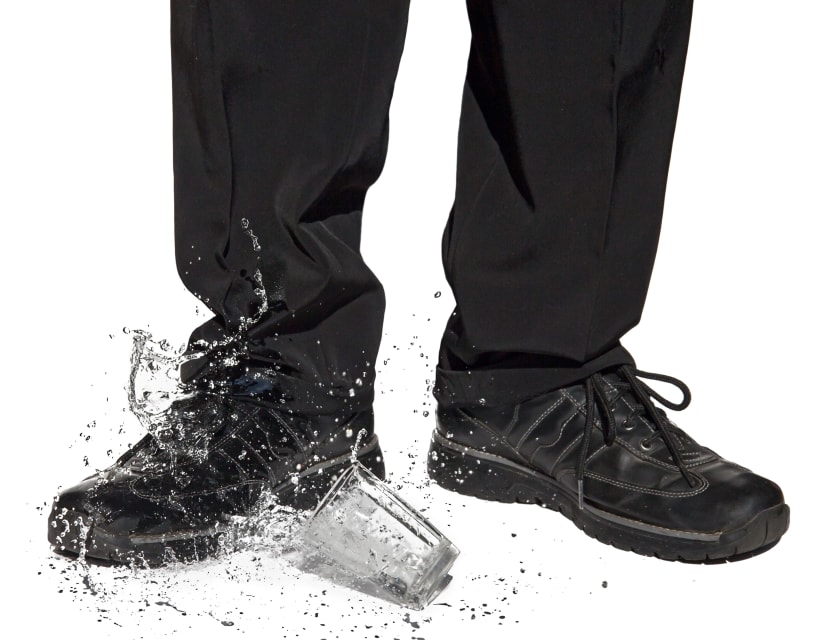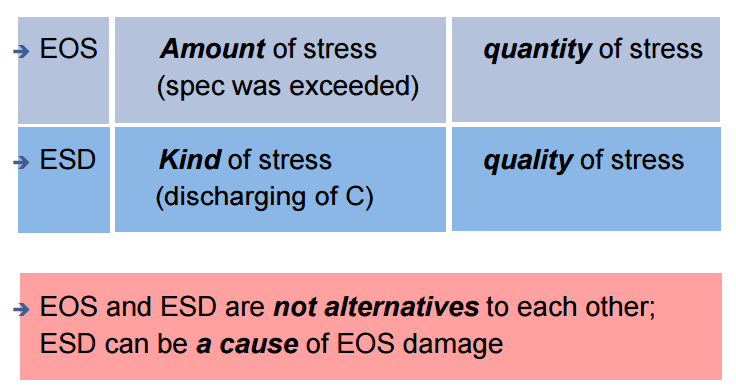The Difference between EOS and ESD
Follow articleHow do you feel about this article? Help us to provide better content for you.
Thank you! Your feedback has been received.
There was a problem submitting your feedback, please try again later.
What do you think of this article?
Electrical Overstress, or EOS, has become a widely-used term over the past few years. However, a lot of people are still unsure as to what exactly it is and how it differs from ElectroStatic Discharge (ESD). Today’s blog post is intended to put an end to the confusion.
What is Electrical Overstress?
One huge problem with Electrical Overstress, or EOS, is the fact that people use the phrase in different ways. Up until now there has been no widely recognised definition. A White Paper on EOS published by the Industry Council on ESD Target Levels in 2016 uses the following definition: “An electrical device suffers an electrical overstress event when a maximum limit for either the voltage across, the current through, or power dissipated in the device is exceeded and causes immediate damage or malfunction, or latent damage resulting in an unpredictable reduction of its lifetime.“
Simplified, EOS is the exposure of a component or PCB board to a current or voltage beyond its maximum ratings. This exposure may or may not result in a catastrophic failure.
ElectoStatic Discharge (ESD) versus Electrical Overstress (EOS)
You can compare an ESD event with a knocked-over glass of water on a floor: you’ll get a small puddle but once all the water has spilt from the cup, it’s gone. There is no more water left and the damage is fairly limited. [Source]
ESD can be compared to a knocked-over glass of water
However, an EOS event can be compared to an open tap; there may be just a little drip in comparison but there is an unlimited amount of water available. After a while, the entire floor may be flooded and could cause some serious damage. As you can see, EOS events last several magnitudes longer than most ESD events. [Source]
EOS can be compared to a dripping tab
By many, ESD is seen as just one type of electrical stress. EOS on the other hand, describes a wide number of outcomes resulting from multiple stresses or root causes. ESD does not require a “victim” or damaged product. There will be an ESD event if two objects are at different charge levels and a rapid, spontaneous transfer of an ElectroStatic charge between them occurs. An electrical stress can only become an overstress (as in EOS) if we’re aware of how much stress the “victim” (i.e. sensitive device) can withstand. One specification used to document these limits is the “Absolute Maximum Rating” (AMR). More on that in a little while. Back to EOS and ESD for now. The below image highlights the relationship and contrast between EOS and ESD:
Relationship between EOS and ESD [Source]
Generally speaking, EOS describes extreme signals other than ESD. The following table lists the main differences:
| ESD Event | EOS Event | |
| Cause |
Rapid discharge of accumulated charge |
Voltage and/or currents associated with operation of equipment or with power generating equipment |
| Duration | Once accumulated charge is consumed, ESD event can no longer manifest itself | Lasts as long as originating signals; no inherent limitation |
| Characteristics | Have specific waveform which includes rapid rising edge and asymptotic read edge | Can have any physically possible waveform as sources of EOS are often unpredictable |
| Occurrence | Non-periodic and non-repeatable (accumulation of charge cannot be guaranteed) | Mostly (but not always) periodic and repeatable |
Differences between EOS and ESD [Source]
The importance of Electrical Overstress (EOS)
Many failures in the electronics industry can be contributed to EOS. Yes, ESD has received a lot of attention over the past years. However, ESD represents only a small percentage of total EOS damages.
Typical causes of device failures [Source]
As explained further above, EOS and ESD are NOT the same thing. This is extremely important because:
- EOS damages are much more common compared to failures caused by ESD.
- A comprehensive ESD Control Programme will provide protection against ESD but not EOS.
Now that you have learnt what EOS is, how it’s different from ESD and that ESD protection is not effective for EOS damage, the obvious question will be “How can I protect my sensitive devices from EOS failures?”. That’s where we go back to our “Absolute Maximum Rating” (AMR) mentioned earlier.
Absolute Maximum Rating (AMR) and Electrical Overstress (EOS)
We’ve established earlier that EOS is caused by exceeding specific limits of a device, the so called Absolute Maximum Rating or AMR.
AMR represents “the point beyond which a device may be damaged by a particular stress” [Source].
Interpretation of AMR* [Source]
*the yellow line represents the number of components suffering catastrophic damage
- Region A is the safe operating area in which devices are to operate as anticipated.
- Region B does not guarantee for the device to function as it should. No physical damage is expected in this area; however, if a device is operated in this region for extended periods of time, it may cause reliability problems.
- The upper limit of region B represents the AMR. Issues will arise if a device is operated beyond this point.
- Region C is the first area of electrical overstress causing latent failures.
- Region D is the second area of electrical overstress causing immediate damages.
Protecting your sensitive devices from Electrical Overstress (EOS)
As already stated, ESD Protection measures are useless when it comes to protecting your sensitive devices from EOS. “Rather, improvement and mitigation of EOS failure causes will only advance through better communication between the supplier and the customer. This includes proper understanding of AMR, realistic specifications for it, finding the root cause of EOS damage incidents, and identifying the field and system application issues.” [Source]
References:
- Industry Council on ESD Targets: White Paper 4: Understanding Electrical Overstress – EOS
- In Compliance: Rethinking Electrical Overstress
- EEWeb: Electric Overstress (EOS) and Its Effects on Today’s Manufacturing
- Dangelmayer Associates/ESD Association: Electrical Overstress – Many Sources; Any Solutions?






